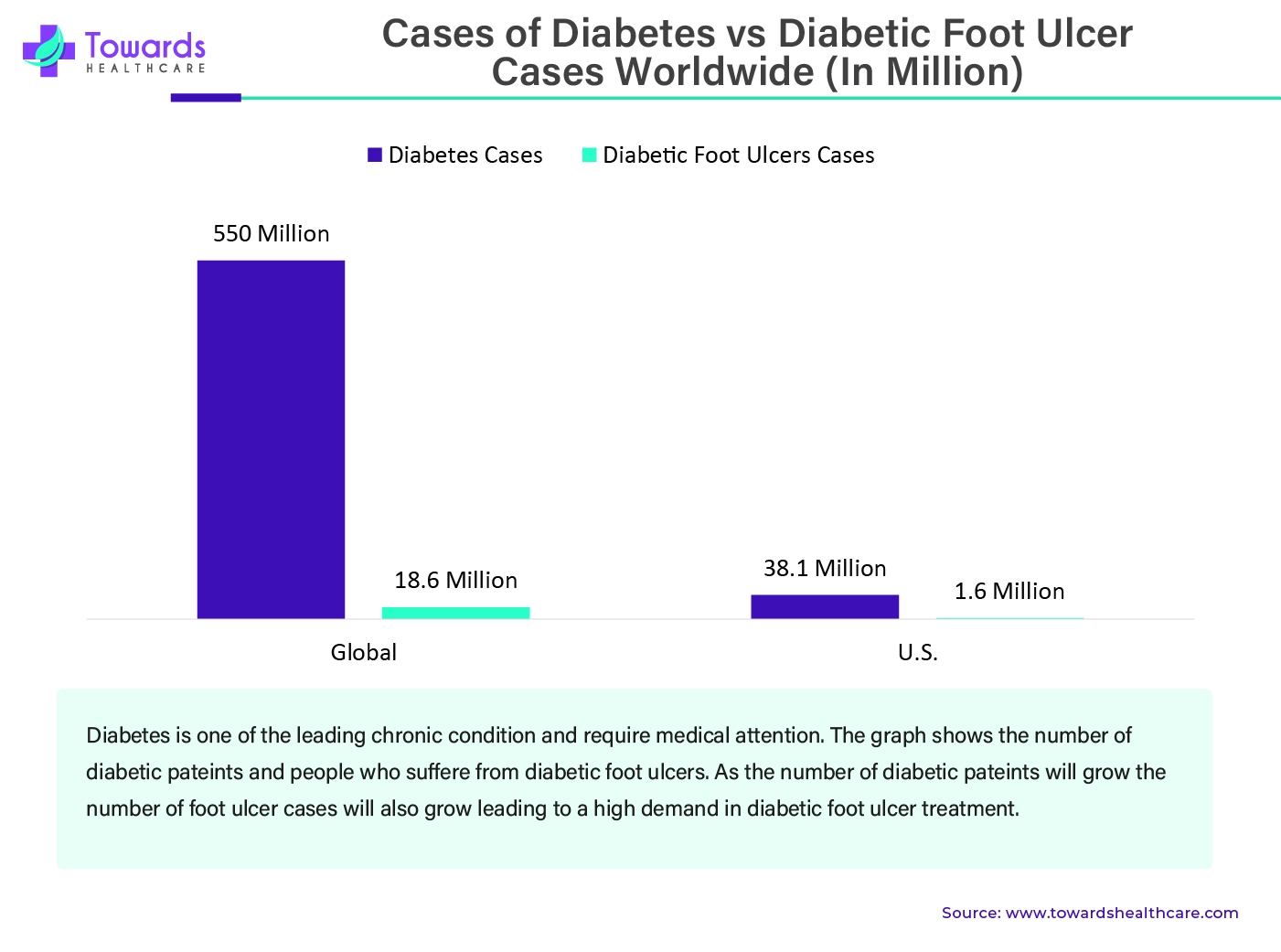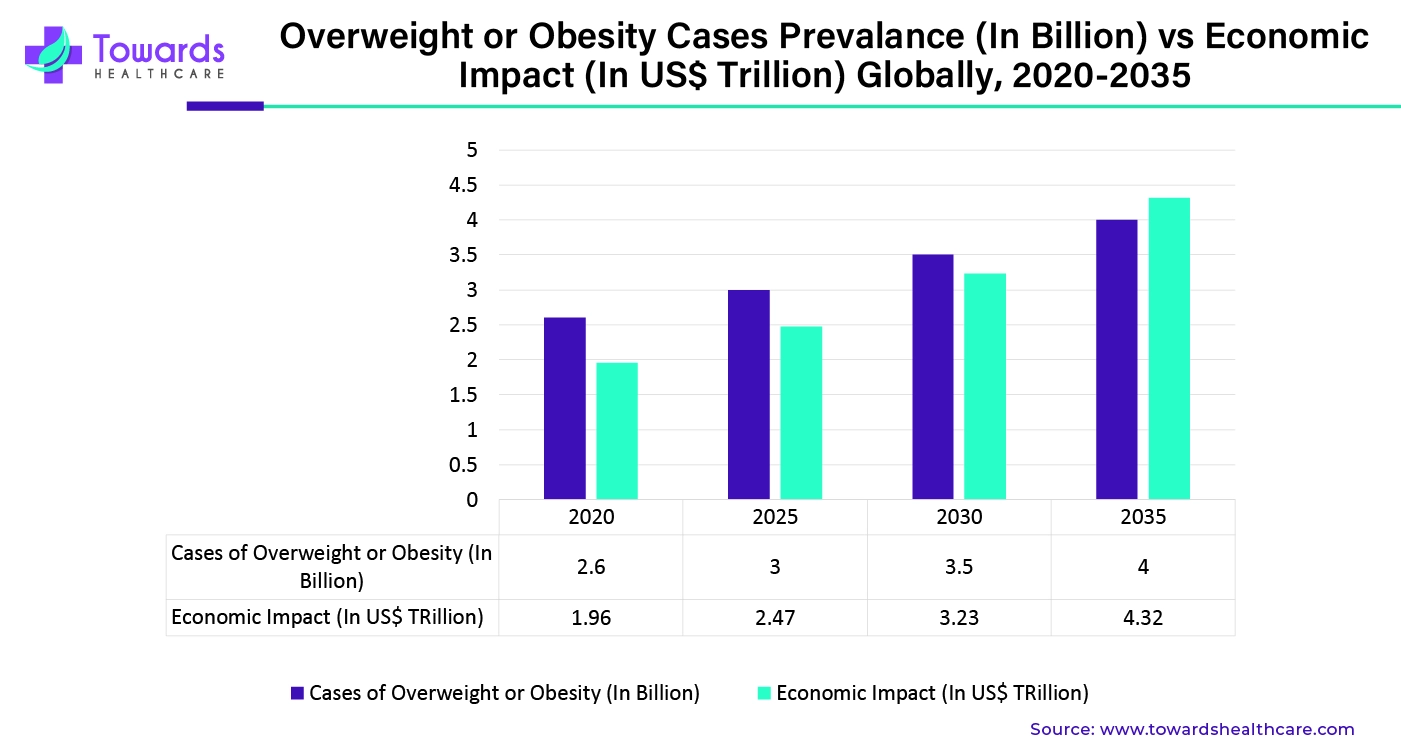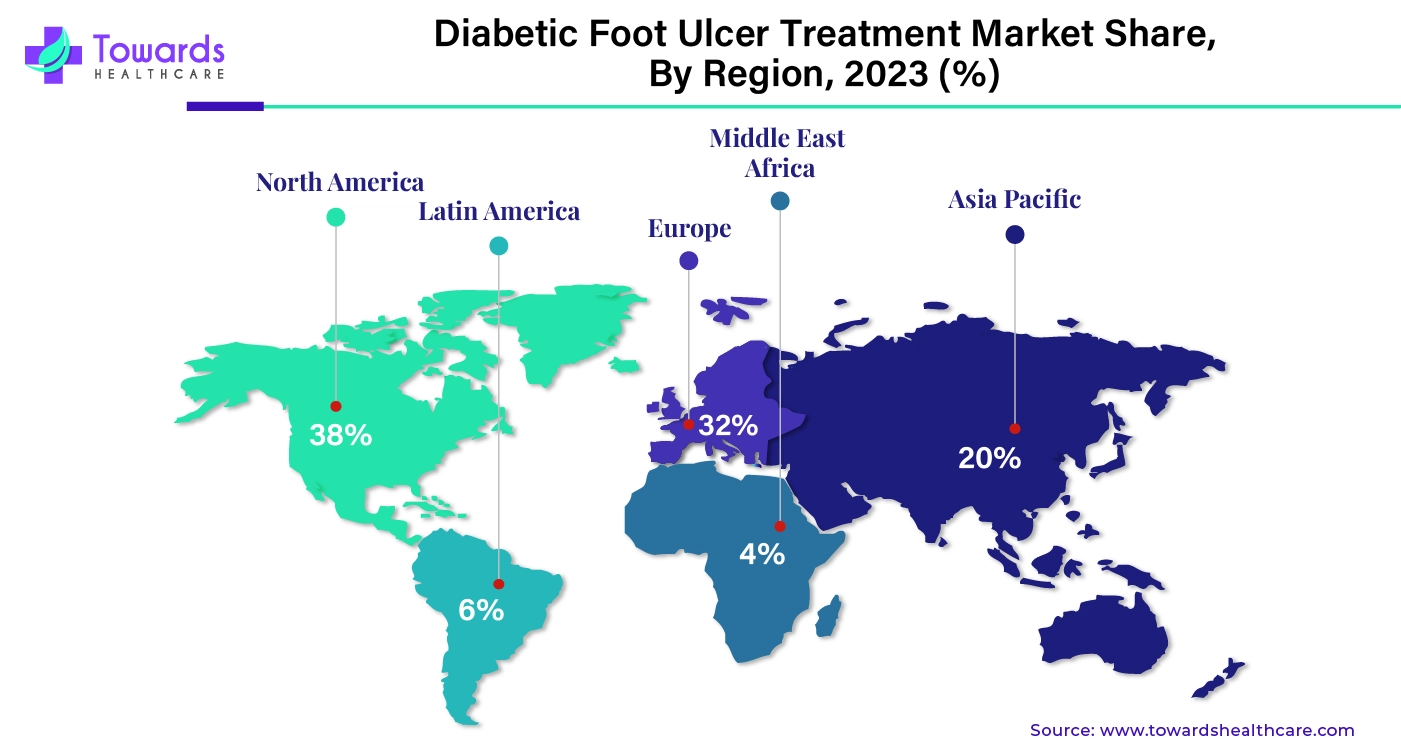December 2025

The global diabetic foot ulcer treatment market size was estimated at US$ 5.85 billion in 2025 and is projected to grow to US$ 10.52 billion by 2035, rising at a compound annual growth rate (CAGR) of 6.04% from 2026 to 2035.

| Key Elements | Scope |
| Market Size in 2026 | USD 6.21 Billion |
| Projected Market Size in 2035 | USD 10.52 Billion |
| CAGR (2026 - 2035) | 6.04% |
| Leading Region | North America by 38% |
| Market Segmentation | By Treatment, By Ulcer Type, By End-use, By Region |
| Top Key Players | Acelity L.P., Inc., IPCA Laboratories, ConvaTec, Group Plc, Novalead Pharma, Coloplast Corp., B Braun Melsungen AG, Medtronic Plc, Medline Industries, LP., Smith & Nephew Plc, 3M Health Care, Molnlycke Health Care AB |
Diabetic foot ulcers occur in approximately 15% of people who are suffering from diabetes. Diabetic foot ulcers are open sore wounds that can lead to hospitalization due to infection or other complications. The diabetic foot ulcer treatment market deals with the products of medicines and devices for treating foot ulcers. The market is also associated with research and development, evidence-based patient treatment, and other aspects of diabetic foot ulcers. The growing number of foot ulcers is due to the growing number of diabetic patients worldwide. The heavy consumption of high-calorie food, physical inactivity, sedentary lifestyle due to occupation, and other factors have led to the growing number of diabetes.

Numerous advances have occurred in the screening, detection, and treatment of diabetic foot ulcers (DFU) using artificial intelligence (AI). AI-based software and applications have been developed to help healthcare professionals and patients. These systems are trained & tested using DFU datasets. AI and machine learning help in ongoing research and increase the accuracy and efficiency of DFU treatment. AI has automated various systems and processes that have improved patient care and reduced the healthcare burden and overall cost associated with DFU and diabetes.
For instance,

The infographic above shows the growing cases of obesity and how it is going to economically impact the healthcare industry. It is estimated that the cases will rise from 2.6 billion in 2020 to 4.0 billion in 3035, and the economic impact will increase in trillions.
One of the driving factors of the diabetic foot ulcer treatment market is the growing prevalence of diabetes. It is estimated that the cases of diabetes mellitus will become a critical pandemic in the future. According to the International Diabetes Federation, there will be approximately 783 million cases of diabetes by the year 2045. One of the leading causes of diabetes is growing cases of obesity. Obesity is a growing concern and leads to type 2 diabetes. Junk food, unhealthy eating habits, alcohol consumption, inactive lifestyle, etc leads to obesity. Excessive body fat is the main cause behind the occurrence of type 2 diabetes. It is estimated that overweight and obesity will have an economic impact of US$ 4,32 trillion annually on a global level by 2035.
The high cost of DFU treatment restrains the growth of the diabetic foot ulcer treatment market. It can take anywhere from weeks to several months for foot ulcers to heal, which leads to longer hospital stays, continuous medicine consumption, patient monitoring, and utilization of other healthcare facilities. All these factors increase the cost of DFU treatment. The per capita cost for the treatment of DFU in America is around US$ 17,500, and the annual mean cost for the treatment per person is around US$ 1399. The majority of people who belong to the lower and middle classes cannot afford DFU treatment. With the increase in inflation and lack of insurance, treating DFU might even cost more in the future.
Current treatment options for DFU in the market have some limitations, including the time of healing. With the current treatment options, it takes weeks to several months to heal DFU. The diabetic foot ulcer treatment market can grow in the future if research institutions, hospitals, biopharma companies, biotech companies, and government institutions take the initiative to develop new drugs and treatment procedures to reduce the healing period. With the integration of AI and machine learning algorithms, the accuracy and pace of research can be increased. It can lower the burden on healthcare professionals and resources, which will reduce the cost associated with the treatment. Lower costs can increase patient admissions and patient satisfaction.
Why Did the Biologics Segment Dominate in the Market?
By treatment, the biologics segment dominated the diabetic foot ulcer treatment market in 2025. Biologics are biological products like immune modulators, vaccines, growth factors, monoclonal antibodies, etc, that are derived from biological systems such as human cells. Biologics or biological therapies are being heavily used in research to study diseases, drug testing, and drug and therapy development. In the case of DFU treatment, biological therapies are considered due to their advantages of fewer side effects and lower toxicity. Biologics are also useful in decreasing inflammatory response and oxidative stress markers. Due to the several advantages of biologics, they have become an ideal choice for healthcare professionals who treat DFU.
Fastest Growing: The Therapy Devices Segment
By treatment, the therapy devices segment is anticipated to grow at the fastest rate in the diabetic foot ulcer treatment market during the forecast period. Negative pressure wound therapy and ultrasound therapy are the two commonly used therapies that are given with the help of therapy devices. Diabetic offloading devices are used for redistributing pressure, which reduces the chances of ulcers and infection. Ultrasound therapy is a non-invasive and versatile technology that has been used in recent years. Both therapies provide exceptional results, due to which there has been growing research on developing more such therapies, and the therapies are being widely used across the globe for treating DFU.
For instance,
How Neuro-Ischemic Ulcers Segment Dominated the Market?
By ulcer type, the neuro-ischemic ulcers segment held the largest share of the diabetic foot ulcer treatment market in 2025 and is expected to grow at the fastest rate during the predicted time period. The segment is growing because neuro-ischemic is the most common type of DFU that occurs in a diabetic person. It is estimated that out of all the DFU cases, 50% of cases turn out to be neuro-ischemic cases. Due to this, it is the most commonly studies DFU for developing better treatment options. Among the various treatment options, sucrose octasulfate dressing is used for the treatment of neuro-ischemic ulcers.
For instance,
What Made Homecare the Dominant Segment in the Market?
By end-use, the homecare segment accounted for the largest share of the diabetic foot ulcer treatment market, and the segment is estimated to grow at the fastest CAGR. DFU is a chronic condition that can take weeks to months to heal. Therefore, home care is the commonly used practice for preventing and treating DFU. Patients can hire home care help from professionals or can get help from family members. Healthcare professionals provide education, guidance, and training to patients and caregivers to ensure proper preventive measures and treatments are done for DFU. Also, due to growing technological advancements, there has been a surge in telehealth and telemedicine, which is working in favor of home care.

By region, North America dominated the diabetic foot ulcer treatment market share by 38% in 2025. North America dominates healthcare research and development, healthcare infrastructure and facilities, the pharmaceutical and biotechnology industries, and technological advancements, which have helped the market grow in North America. The countries that majorly contribute to the market’s growth are the U.S. and Canada in the North American region.
U.S. Market Trends
The U.S. dominated the diabetic foot ulcer treatment market due to advanced healthcare facilities and the growing prevalence of obesity and diabetes. The U.S. is known for consuming high-calorie beverages and food. The U.S. also has the largest number of fast-food chains. All these factors contribute to obesity and diabetes. Obesity is a very common health issue in the U.S., and more than 2 in 5 adults in the U.S. have obesity. More than 70 million adults are obese, and 99 million are overweight in the U.S. The medical cost associated with obesity in the U.S. ranges from US$ 147 billion to US$ 210 billion annually.
Diabetes is also a growing issue in the U.S. According to the CDC, around 98 million Americans have prediabetes, and more than 30 million people have been diagnosed with diabetes. Diabetes is the 7th leading cause of death in the U.S. The U.S. government has launched various programs to tackle diabetes, including the Lifestyle Change Program and the National Diabetes Prevention Program.
By region, Asia Pacific is expected to grow at the fastest rate during the forecast period. Asia Pacific’s diabetic foot ulcer treatment market is growing due to growing investments by the governments, key market players, and growing awareness about diabetes. China, India, South Korea, and Japan are major contributors to the growth of the market. The growing population and the growing cases of obesity and diabetes in the Asia Pacific region further promote the growth of the market.
China Market Trends
There is a severe economic burden on China's healthcare system. In 2020, there were 140.87 million cases of diabetes mellitus in China, and it is estimated that the number will grow to 164.07 million in 2030 and 174.43 million in 2045. It is estimated that the economic burden will rise from US$ 250.2 billion to US$ 460.4 billion from 2020 to 2030.
India Market Trends
The growing prevalence of obesity and diabetes in India is also contributing to the growth of the diabetic foot ulcer treatment market. It is estimated that more than 100 million people in India struggle with obesity, out of which 14.4 million are children. India is also leading in the number of diabetic patients. According to the Ministry of Health and Family Welfare, there were 101 cases of diabetes in India in 2023, and it is estimated that the number will grow to 134 million by 2045.
Europe is considered to be a significantly growing area, owing to the rising prevalence of diabetes and its complications. Approximately 61 million Europeans are living with type 2 diabetes, accounting for 95% of all diabetes cases. The growing research and development activities and the increasing awareness of diabetes care boost the market. Several researchers use advanced technologies to develop novel and innovative biological products for treating diabetic foot ulcers. Favorable government policies and increasing research funding augment market growth.
Germany Market Trends
The prevalence and incidence of diabetic foot ulcers were 4.6% and 2.1% in Germany, according to a population-based analysis published in 2025. Key players, such as Evonik and Aurealis Therapeutics, are the major providers of diabetic foot ulcer treatments in Germany. Diabetes imposes a large economic burden on people in Germany. It is estimated that the total costs would reach around €2 billion and €79 billion for type 1 and type 2 diabetes, respectively, by 2040.
UK Market Trends
The prevalence rate of type 2 diabetes in adults over 17 years was 7.0% in March 2024, an increase of 6.8% from March 2023. The UK government formed the “National Service Framework for Diabetes” that sets out new standards and key interventions to raise the standards of diabetes care.
South America is expected to grow notably in the diabetic foot ulcer treatment market during the forecast period, due to the growth in the diabetic population. At the same time, the growing geriatric population and healthcare investments are also driving the adoption of various treatment options and are encouraging innovations, enhancing the market growth.
Brazil Market Trends
The demand for diabetic foot ulcer treatment in Brazil is increasing due to the growing diabetic patients and increasing health awareness. This, in turn, is supporting the development of various advanced therapies, where the expanding healthcare sector is promoting the use of telemedicine platforms to enhance their access.
MEA is expected to show lucrative growth in the diabetic foot ulcer treatment market during the forecast period, due to expanding healthcare, which is increasing the adoption of various treatment options. At the same time, the growing incidence of diabetes and increasing government initiatives are also increasing their demand, promoting the market growth.
Saudi Arabia Market Trends
The growing healthcare investments and diabetes rates across Saudi Arabia are increasing the demand for diabetic foot ulcer treatment. Furthermore, the growing government initiatives are also supporting the innovations, where companies are developing advanced wound care solutions and telehealth platforms.
The R&D for diabetic foot ulcer treatment involves the development of regenerative medicine and smart wound management solutions.
Key players: Cellularity Inc., Rion Inc.
Incidence of complete wound closure and time to heal are evaluated in the clinical trial and regulatory approval of diabetic foot ulcer treatment.
Key players: Kerecis, Smith+Nephew.
The patient support and services in the diabetic foot ulcer treatment involve remote patient monitoring (RPM) and integrated wound care programs.
Key players: Podimetrics, Orpyx Medical.
| Company Name | IPCA Laboratories |
| Headquarters | Maharashtra, India, Asia Pacific |
| Recent Development | In August 2024, Diulcus, a topical gel that costs Rs 1365 a pack and is intended to treat diabetic foot ulcers, was introduced by IPCA Laboratories. Esmolol, a modified beta blocker, serves as the foundation for the gel. Upon approval following clinical studies, the device demonstrated encouraging rates of ulcer closure (77.20%), and IPCA aims to capture a significant portion of the market in three years. IPCA Labs wants to sell a novel medication for diabetic foot ulcers for Rs 100 crore. |
| Company Name | Novalead Pharma |
| Headquarters | Maharashtra, India, Asia Pacific |
| Recent Development | In July 2024, Executives from the drug repurposing startup Novalead Pharma stated that they plan to collaborate with a pharmaceutical firm in order to introduce their innovative diabetes foot ulcer (DFU) gel early next month. After around $10–12 million was spent on research, an additional $65 million was needed to bring the medication to the U.S. and Europe. |
By Treatment
By Ulcer Type
By End-use
By Region
December 2025
December 2025
December 2025
November 2025